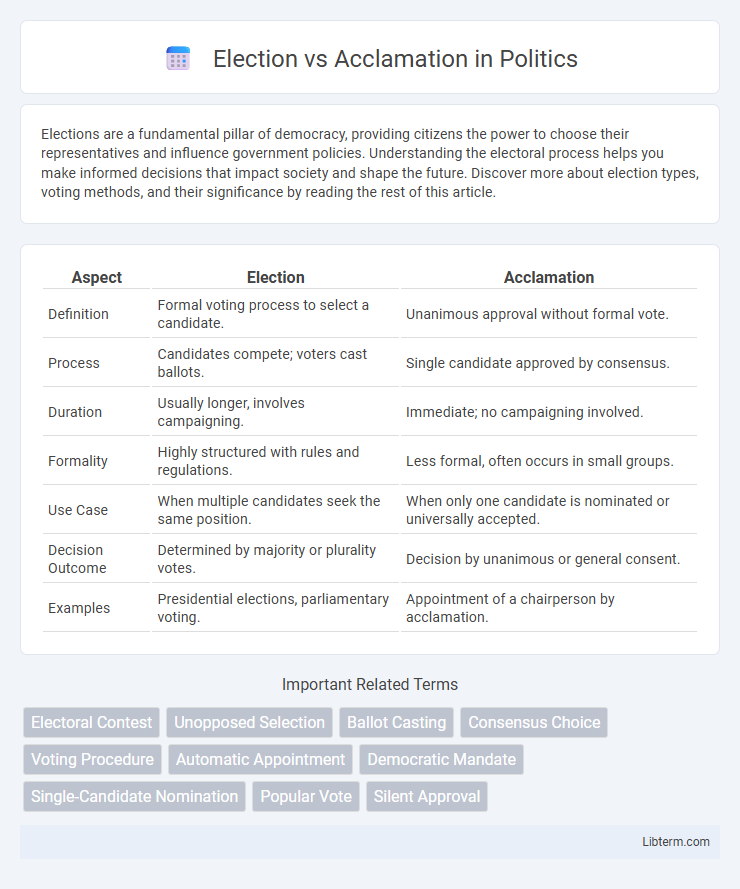Elections are a fundamental pillar of democracy, providing citizens the power to choose their representatives and influence government policies. Understanding the electoral process helps you make informed decisions that impact society and shape the future. Discover more about election types, voting methods, and their significance by reading the rest of this article.
Table of Comparison
| Aspect | Election | Acclamation |
|---|---|---|
| Definition | Formal voting process to select a candidate. | Unanimous approval without formal vote. |
| Process | Candidates compete; voters cast ballots. | Single candidate approved by consensus. |
| Duration | Usually longer, involves campaigning. | Immediate; no campaigning involved. |
| Formality | Highly structured with rules and regulations. | Less formal, often occurs in small groups. |
| Use Case | When multiple candidates seek the same position. | When only one candidate is nominated or universally accepted. |
| Decision Outcome | Determined by majority or plurality votes. | Decision by unanimous or general consent. |
| Examples | Presidential elections, parliamentary voting. | Appointment of a chairperson by acclamation. |
Understanding Election and Acclamation
Election involves a formal voting process where candidates are chosen based on majority or plurality support, ensuring democratic participation. Acclamation occurs when a candidate is unopposed or unanimously approved, eliminating the need for a formal vote and reflecting consensus or lack of opposition. Understanding these methods highlights the contrast between competitive selection and unanimous approval in decision-making.
Key Differences Between Election and Acclamation
An election involves a formal voting process where candidates compete for a position and voters cast ballots to determine the winner, ensuring a democratic selection. Acclamation occurs when a single candidate is unanimously approved without a vote, typically due to lack of opposition, signifying unanimous consent or consensus. The key difference lies in the presence of competitive voting in elections versus the uncontested approval in acclamation.
Historical Context of Election and Acclamation
Election and acclamation have distinct historical contexts rooted in different decision-making processes for leadership selection. Historically, elections emerged as formalized systems enabling representative choice through voting, often requiring ballot casting and majority rule in ancient Greek and Roman republics. In contrast, acclamation dates back to earlier communal or tribal practices where leaders were chosen by public vocal approval or unanimous consent without ballots, symbolizing collective agreement and immediate endorsement in civic assemblies.
Advantages of Elections
Elections ensure a transparent, democratic process by allowing multiple candidates to compete, giving voters the power to choose their preferred representative. This competitive environment promotes accountability, encourages diverse viewpoints, and enhances legitimacy by reflecting the electorate's true preferences. Furthermore, elections help prevent bias and reduce the risk of unqualified candidates assuming office, contributing to a stronger governance system.
Benefits of Acclamation
Acclamation offers a streamlined and efficient method for selecting candidates without the need for formal voting, reducing administrative costs and time. It fosters unity by showcasing unanimous support, minimizing divisiveness common in competitive elections. This approach also simplifies decision-making in small groups or contexts where consensus is clear, enhancing organizational harmony.
Common Scenarios for Each Method
Election is commonly used in competitive scenarios where multiple candidates vie for a position, such as political offices or corporate board seats, ensuring a fair and democratic selection process. Acclamation occurs when a candidate is unopposed or unanimously supported, often seen in small organizations, committees, or during uncontested leadership roles. This method streamlines decision-making by confirming consensus without the need for formal voting.
Legal Frameworks Governing Elections and Acclamations
Legal frameworks governing elections and acclamations differ significantly based on jurisdiction, outlining specific procedures for candidate nominations, voter eligibility, and dispute resolution. Election laws mandate formal voting processes to ensure transparency, fairness, and representation, while acclamation occurs when a candidate is unopposed, allowing for automatic appointment without a formal vote. Statutes often specify conditions under which an acclamation is valid, emphasizing adherence to regulatory standards to maintain democratic legitimacy.
Public Perception and Legitimacy
Election processes convey public perception of fairness and inclusivity by allowing voters to actively choose candidates, thereby enhancing legitimacy through demonstrated popular support. Acclamation, while efficient, may raise concerns about legitimacy due to the absence of a competitive vote, potentially leading to perceptions of limited transparency or democratic deficit. Public trust in governance structures often correlates with visible electoral competition, making elections a preferred method for affirming representative authority.
Challenges and Controversies
Election processes often face challenges such as voter fraud, manipulation, and lack of transparency, leading to disputes and legal battles. Acclamation bypasses voting but can prompt controversies over legitimacy, inclusiveness, and potential coercion within the decision-making body. Both methods require robust safeguards and clear guidelines to ensure fairness and public confidence in leadership selection.
Choosing the Right Method: Election or Acclamation
Choosing between election and acclamation depends on the level of consensus and formality required in decision-making. Election involves a formal voting process where candidates compete, ensuring democratic legitimacy and transparency. Acclamation is suitable for uncontested positions, reflecting unanimous agreement without the need for a ballot, streamlining the selection process.
Election Infographic

 libterm.com
libterm.com